More Monsters from the Monster Manual.
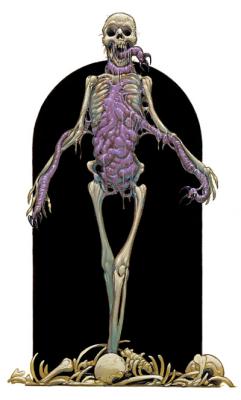
The Mohrg looks both icky and also pretty cool. It’s a human skeleton whose chest is filled with purple worms. It is however not a worm riding a human skeleton, but really a single undead creature that is created from a murderer who died unpunished. And it seems to be implied that it is the evil soul that makes the criminal return to unlife and not the work of a necromancer, which really raises the question where these worms are coming from? Perhaps the artist got unclear instructions what it should look like. A morg attacks both with its hands and its tongue, which in this illustration is also a worm. The tongue causes paralysis in living creatures, while it can also use the Improved Grab ability when it hits with its arms. Since humanoid ceatures never have the Improved Grab ability, I would guess the best way to describe it in combat would be to have the worms that are wrapped around the arm bones wrap around the target and hold it. The players sure would appreciate it. A mohrg is much more powerful than a skeleton and other than in appearance has nothing at all in common with those. When a creature is killed by a mohrg it raises as a simple zombie, but only after one to four days. Which in completely useless in combat, and you would have to add a lot of zombies to make a fight against a CR 8 monster more challenging. Considering all this, the writer who created the mohrg probably had much more in mind for it than just being a stronger skeleton to jump out from behind a corner and be killed in two to three rounds. This creature is really much better suited as the centerpiece of an entire adventure. One to four days is quite some time in which a lot can happen to a corpse. The mohrg might take it back to its lair and wait for it to rise, or it might be left where it fell. Or it might even have been found and already burried in the graveyard or being prepared for burrial. Suddenly, zombies! Zombies everywhere! A great investigation adventure which at the end will come together with a fight against the mohrg itself. Which being a murderer in life, should also have some backstory to go along with. This is exactly the kind of hidden information I am looking for in these books. Monsters that are much more than something to encounter standing in a dungeon room and to be forgotten four rounds later, but are actually made to have adventures created around them. And I must ask, why doesn’t this book spell this out?! This book is 15 years old, I had it since it first came out, and I have been using it countless times. And only now, carefully disecting each obscure monster and searching for tiny details that might be used as plot hooks, did I ever notice it? “1d4 days” is only seven characters, but they make all the difference. Why hide it? Would it have been so hard to add two more sentences to the description? Imagine if they had made that effort for all monsters in this book? D&D would be a completely different game than it is today and not the rules obsessed tactical combat simulation that it became.
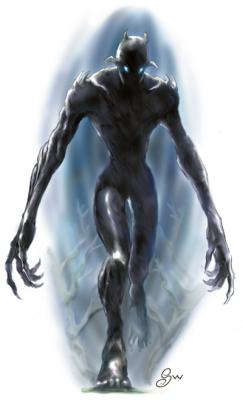
Do I have to say it again? I probably shouldn’t, but I’ll do anyway: This Nightshade illustration is fucking awesome! Like almost all Sam Wood illustrations in this book. The perspective makes it clear that this is a not a human sized guy and when you check the description it’s fucking huge. Not just big, but size category: Huge. A 6 meter tall bastard of pure darkness with blue glowing eyes. Nightshades come in three variants, the nightwing (huge bat), nightwalker (huge man), and nightcrawler (gargantuan worm) and are from the Known World setting of BECMI. Which I think is the reason for its biggest flaw. In BECMI, character levels go all the way up to 36, almost twice as high as the maximum of 20 in the 3rd edition core rules. Unfortunately, when converting the creature this difference was apparently not accounted for making the nightshades pretty high level creatures with a CR of 16 for the nightwalker. Which means I never got any opportunity to use it. Let me get my soap box, I think I need it today. I hate high level play in D&D. My campaigns usually don’t go any longer than 3 years and almost all of them start at low levels, because I very often get lots of people to play who never played any RPGs before. And since I don’t run dungeon crawling grind-fests, I’ve never seen any PCs of a level higher than 8th, either as GM or as player. And the way D&D is set up, that meant a huge amount of content never could be used at all. Like this cool badass bastard. Today I know better and could just rebuild him as a CR 8 creature and use that, but I used to be a young and stupid GM and that never really occured to me. I am afraid I don’t have much to say about the monster itself. There isn’t really any description what it is and what it does, and the abilities don’t seem interesting either. But damn, it looks cool.
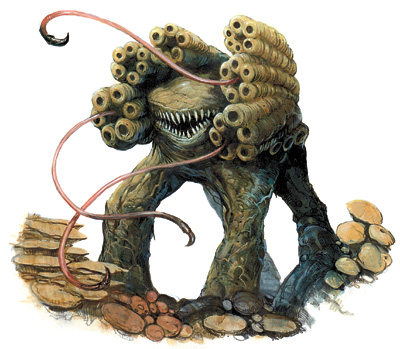
The Phantom Fungus looks very weird and kinda stupid in this illustration. Which doesn’t actually matter because it’s completely invisible almost the entire time. The stats for this monster are really very simple. It’s medium size, has animal intelligence, and is only CR 3. It’s natural invisibility is the only ability it has. Actually, you could just ignore the illustration since none of those things on its back or the tentacles coming out of them are doing anything. It is permanently invisible, walks up to you, and bites. Clearly the artist thought that this is totally boring and painted something much more interesting, if stupid looking, instead. The invisibility really is its only thing. I think the best idea is probably to just take this ability and add it to other creatures and make some really interesting monsters.
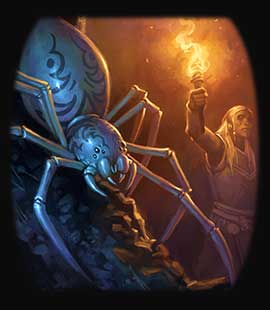
A Phase Spider is an intelligent kind of giant spider with the ability to jump between the material and ethereal planes. Since the picture in the Manual is super dull, I took this much more interesting looking one instead. Regarding their abilities, phase spiders are very simple. It’s just like a giant spider that also can use ethereal jaunt like the ethereal filcher and ethereal marauder. So it’s a teleporting spider. I loved and hated them playing Baldur’s Gate. A kind of monster I love to hate. But I think the most interesting aspect of them is that they are really very intelligent creatures and not mindless animals. They can not speak in humanoid languages, but with an Intelligence score of 7 they should be able to very effectively communicate with each other. And that makes an annoying teleporting monster in an actually very dangerous teleporting monster. These guys have no reason to just jump out and attack until they eventually run out of hit points. And just running away from their lair also doesn’t mean they forget about you. They are not smart in any way, but they are intelligent monsters, not stupid beasts. Playing them intelligent could make for really interesting adventures and more than just a single encounter. Speaking of which, I recommend reading this article by The Angry DM about encounters and combat, which among other things explains why there is no such thing as a “combat encounter”. The phase spider here is a very good example for why an encounter even with a hostile monster doesn’t start and end with initiative.
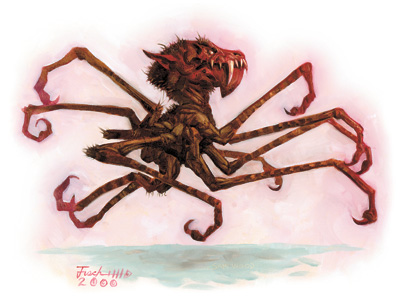
The Rast is a creature from the Elemental Plane of Fire. It certainly looks very weird. But I think the illustration doesn’t do justice to the description. “Its round head is almost all mouth, and its mouth is almost all teeth.” Rasts are very slow on the ground and actually move around by flying, with its thin legs being used mostly to attack. Rasts exist to eat. Everything and all the time. They have a paralyzing gaze that can paralyze creatures for a couple of rounds and will then concentrate its attack on those still able to fight. When they hit with a bite, they can keep the target held in place and drain 1 point of Constitution per round. Yeah, it looks freaky, but I really don’t have any idea what to do with it.
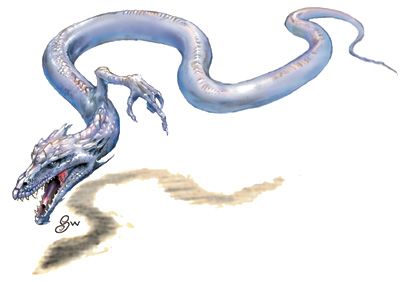
The Ravid is a creature from the Positive Energy Plane. And probably in this book to remind us that the Positive Energy Plane is a thing. It’s a flying snake of medium intelligence and neutral alignment and has a single arm. Because, why not? It can actually use the claw to make attacks, which really doesn’t seem intuitive based on the picture. Its attacks and damage are lousy, but as a positive energy creature it deals pretty good damage against undead. So maybe it’s intended as an ally? Can you summon it with a summon monster spell? It doesn’t say anything about that here though. The main special ability of the ravid is that it can use the animate object spell and uses it to make things nearby come alive and defend it. The description of the creature says that on the material plane it wanders around aimlessly followed by some animated objects. Which to me very much sounds as if the writer doesn’t have any idea what to do with this thing either.
The Shadow Mastiff is a dog with a scary face. Like most demon dogs, it makes people afraid when it howls. It can also perfectly hide in any shadows during night or underground. (Demon Dog +1)
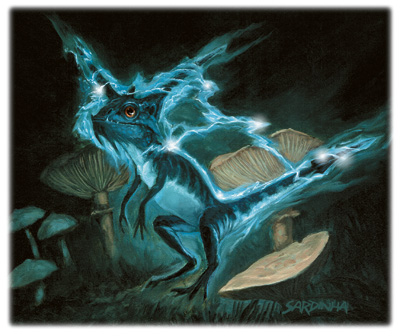
I really almost did not include the Shocker Lizard here as it’s simply a small lizard that zaps you, which seems totally mundane as monsters go. But I couldn’t stop flipping back to it because it’s so damn quirky and funny, and that really is much more important here than weird anatomy. Quirky and funny is what the Fantasy Safari is all about! So yea, it’s just a small blue lizard that for some reason got an entire full page of content. The stats are exactly what you would expect from an ordinary lizard with no surprises, except for that electricity thing. A shocker lizard can zap a creature within 5 feet to deal 2d8 points of nonlethal damage, which is pretty impressive for a creature that size. It’s a lot more than from its laughable bite, even if the target makes the fairly easy saving throw. However, when two shocker lizards are within 6 meters of each other, they can combine their power to allow one of them to create a blast of electricity that deals 4d8 points of lethal damage to everything within 6 meters around it. And you can link even more of them together for a total of 12d8 points of damage and an increasingly higher saving throw difficulty. It doesn’t really say how they create such a charge, but I would assume that it means that any shocker lizard that contributed to anothers lethal shock can not use either the stunning shock or lethal shock ability in that same round. Otherwise you would not just get 12d8 but 72d8 points of damage per round and that very clearly is not EL 7. I am not sure why, but these guys just seem really funny to me. A single one is no threat at all, even for a 2nd level party, as it can only make them unconscious and doesn’t normally eat any large creatures. In groups they become a lot more dangerous. But since they don’t usually attack unless threatened, I think these could make very interesting puzzle encounters in which the players have to find a way to get past a group without getting fried in the process. I never used shocker lizards or even saw them mentioned anywhere by either people or published adventures, but now I think they are actually one of the best low-level creatures in the book. And the picture always looked funny to me.
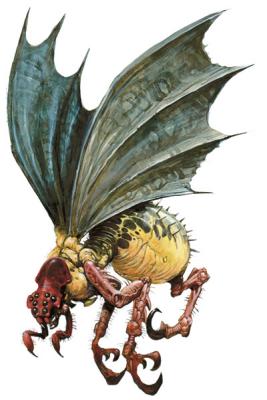
A Spider Eater is a big insect with all the abilities you’d expect from it. It flies, it stings, has poison, yadda yadda. But it’s actually worth a closer look, just as the mohrg. The poison of a spider eater deals no damage, but causes paralysis. Which lasts for 6 to 13 weeks. Which sounds cool but doesn’t actually make any sense, since the creature would die after three or four days from dehydration. Assuming the spider eater has some way to give the paralyzed creature water, it takes six weeks for its legs to hatch, after they have been implanted in the creature. Six weeks is actually quite likely for a human to survive without dying from starvation, especially when not doing any kind of activity. Unlike many other D&D monster books, the entry here doesn’t say what needs to be done to remove the eggs before they hatch. But given that it takes six weeks, this is an obvious adventure setup. Spider eaters poison people, take them to a hidden nest, and the PCs have to find it and save the people before the eggs hatch and the young spider eaters eat them. They also have the freedom of movement ability, which makes it a lot easier for them to hunt spiders, which are they most common prey. The best thing about spider eaters is that they are freaking big, and large enough to be ridden by goblins or halflings, and they can be trained as mounts.
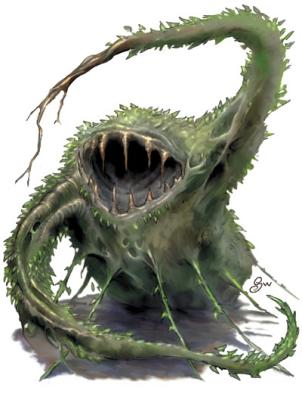
The Tendriculos is a creature I neve used or ever felt like wanting to use, but looking at it more closely I think it’s still something that might be salvagable. It’s a huge plant with a big maw and two long tentacles and weighs almost two tons. It obviously has the whole grab with tentacle and stuff into your mouth thing going on, but is even nastier in that the acid inside its stomach also causes paralysis making it a lot harder to cut your way out. Its most interesting ability is its regeneration. Only blunt weapons or acid deal any real damage to a tendriculos and it can regrow any lost body parts within a couple of minutes. It may be almost as dumb as grass, but with almost a hundred hit points, getting this thing dead should be seriously difficult. Especially when its used as the big bad boss beast of the adventure and the PCs are only 5th level.
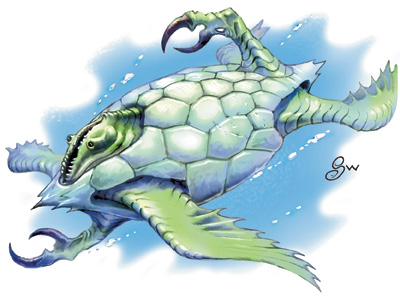
The Tojanida has a bit of a reputation as one of the really crappy monsters of the monster manual. A bit, because nobody ever uses it, but I’ve seen it mentioned quite frequently as the worst monster in the book. A tojanida is an intelligent creature from the Elemental Plane of Water that has a shell like a turtle and four fins, two claws, and one head, which it can pull inside the shell and stick out through any hole it wants, reconfiguring itselg to whatever way it needs. Which is simply weird, but not actually bad. However, like most creatures in this book, there isn’t really word on what tojanidas do, how they behave, and what they want. And cool monsters are actually never about how they look and only to a small degree about what special abilities they have, but really all about their behavior. The alien from the Alien movies is not cool or scary because it has acid blood and can impale people with its tail. It’s cool entirely because of the way it behaves. A monster book that is all about looks and special abilities, but doesn’t explain to you what a creature does is a pretty bad one. Something from which almost all WotC monster books suffer.
Monster Manual Cliche Creature Counter:
- Evil Apes: 1
- Variant Ghouls: 0
- Demon Dogs: 3
- Skeletons with Robes: 0
